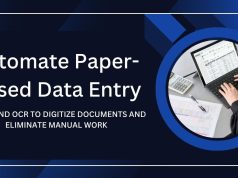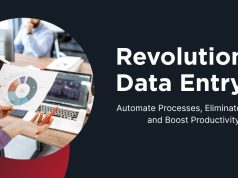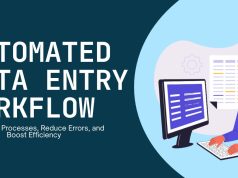Data entry takes hours and time IS money that could be spent on strategic business decisions. And for companies that are processing hundreds, thousands, or tens of thousands of data points each and every day, automation is a must-have if you hope to keep up with the competition and stay efficient.
In this ultimate guide, we’ll take you on a journey to uncover the pitfalls of keyboard entry, the joys of automation, and offer real, applicable advice on automating website data entry awesomely. You will also learn from real-world best practice implementations and see how other institutions were able to simplify their data processing.
The Underlying Costs of Manual Data Entry
Time and Resource Drain
The average employee dedicates 2-3 hours a day to manual data entry chores. This time could be spent on customer service, product development, or strategic planning and development efforts that help businesses to grow.
Manual handling also requires round-the-clock monitoring and quality checks. More employees will need to commit extra time to read and check for data entry mistakes, source other documents to clarify terms, and cross-reference spreadsheets in an attempt to reconcile the information, thus adding extra cost on top of manual methods.

Human Error and Inconsistency
This would have a higher percentage of errors related to manual data entry, which naturally fluctuates between 1-5%, depending on the type and quantity of information. Even error rates that are small become a problem when one is dealing with very large data sets.
Prone to Typos
Typos are among the most common mistakes in manual entry of strconv.
-
Typos and spelling errors
-
Incorrect field mapping
-
Duplicate entries
-
Missing required information
-
Formatting inconsistencies
These mistakes cause issues downstream in reporting accuracy, customer communication, and business decision making.
Scalability Limitations
Manual processing is not scalable, keeping in view the growth of the business. The problem is that when data entry staff is added, overhead increases, and coordination and quality control become very difficult to maintain.
In high-demand episodes or peak seasons, manual workflows are easily overloaded, leaving processing times behind or, perhaps, causing added data clutter, which can affect customer satisfaction and productivity.
Game Changer in Website Data Entry from India
Greater accuracy and more consistent shot string
Systems reduce the possibility of human error with repetitive data entry activities. Information gets processed almost perfectly when you have your gear set up properly with automation tools, which guarantees the consistency of data quality among all entries.
Validation rules can be applied to automatically check your data for errors before adding it to your database – this keeps the information in your database error-free and limits the amount of checking you need to do when processing your data further down the line.
Hours of Time and Money Saved
Processing time is also cut by up to 70-90% using automation rather than manual approaches. This dramatic increase in efficiency enables teams to concentrate on more strategic activities and drive down general operational costs.
The cost for automation tools would be offset within the first 3-6 months in terms of saving labor cost and productivity increase. Savings continue to accrue in the long term as the data/categories increase at a rate that doesn’t necessitate proportional staff expansion.
For better Scalability and flexibility
Adjusting for volume discrepancies is just as easy with an automated system. Whether you’re cranking out 100 or 10,000 entries, the speed of automation will deliver the same value without the need to apply more human resources.
Both new and old automation tools can be updated to handle new data sources, formats, or business needs, offering an adaptability that manual processes simply cannot match.
Processing and Reporting in Real-Time
Automated data processing and immediate access to information for analysis and reporting are facilitated. This speed gives us an edge in making decisions quickly and in providing customer service.
Automated systems can even directly invoke warnings or actions when certain conditions on data have been reached, creating a proactive rather than reactive business response.
Necessary gadgets for website automation and data entry
Web Scraping Tools
-
Octoparse offers an intuitive interface to help users build web scraping workflows without coding. It’s good for dynamic websites, pagination, and complex data structures.
-
Scrapy is more inclined toward advanced users; it is a powerful framework that allows you to write and test your web scraping solutions.
-
Beautiful Soup is good for developers who require the ability to infuse web scraping features into an existing application or create a specific extraction process.
Platforms using Robotic Process Automation (RPA)
-
UiPath has all the RPA functionality, from web data extraction, form filling, and even more complex workflow automation.
-
Automation Anywhere provides enterprise-level automation that packs security features and governance.
-
Power Automate is ideal for organizations already within the Microsoft ecosystem.
API Integration Solutions
-
Zapier lets you link different web apps and have them automatically share data.
-
Microsoft Power Platform offers rich integration and advanced data transformation.
-
Custom API solutions offer ultimate flexibility for unique technical needs.
Form Automation Tools
-
Selenium WebDriver provides an API to perform form submissions and completions in a browser window.
-
iMacros is a specialised automation tool to tackle repetitive tasks related to the web.
10 Best Practices of How to Automate Data Entry into a Website
-
Begin With Clear Objectives and Needs
Document processes and identify pain points. -
The Appropriate Technology for Your Needs
Match tools to business scale, budget, and team skills. -
Enable Robust Error Handling and Monitoring
Build alerts and fallbacks into your automation. -
Keep Data Secure and Compliant
Ensure data protection through encryption, access control, and audit logs. -
Develop a Schedule for Maintenance and Regular Updates
Plan for website changes and ongoing validation.
Real-World Success Stories
E-commerce Price Monitoring
An online retailer automated competitor price monitoring from 50+ sites, removing a 20-hour manual process per week. Result: 15% profit increase.
Real Estate Data Collection
A real estate investment firm cut research time from 40 hours to 2 hours weekly by automating property data collection.
Lead Generation For Financial Services
A financial firm boosted lead generation by 300% and reduced cost per lead by 60% with automated sourcing and qualification.
Measuring Success and ROI
Time Savings Metrics
Quantify direct and indirect savings from automation.
Accuracy Improvements
Measure error reduction and time saved from rework.
Scalability Benefits
Evaluate the ability to handle data growth without extra staff.
How to ’F’ Your Data Entry Automation
Integration of AI
AI-enabled tools can adapt to website changes, handle unstructured data, and make smart decisions.
Cloud-Based Solutions
Scalable, self-updating platforms that require less IT maintenance.
The Nature of the Integration Ecosystem
Deploy API-first solutions for future-proofing and easy integration with CRM, analytics, and BI tools.
Take Your Business to the Next Level with Smart Automation
Web data entry automation is a groundbreaking change from reactive, time-consuming tasks to proactive, intelligent, and optimized business. Businesses that invest in automation stand to gain an immense competitive edge with enhanced efficiency, accuracy, and scalability.
The tools and tactics described here should serve as paths to success, but the beginning is in identifying clear goals, using the best tools available to achieve the goals, and adhering to the ethos of continual improvement.
Automating tasks can help free up resources to focus on other improvements—like optimizing site speed. Once your web data flows efficiently, use our guide on improving your blog’s performance to speed up your site and keep users engaged.










